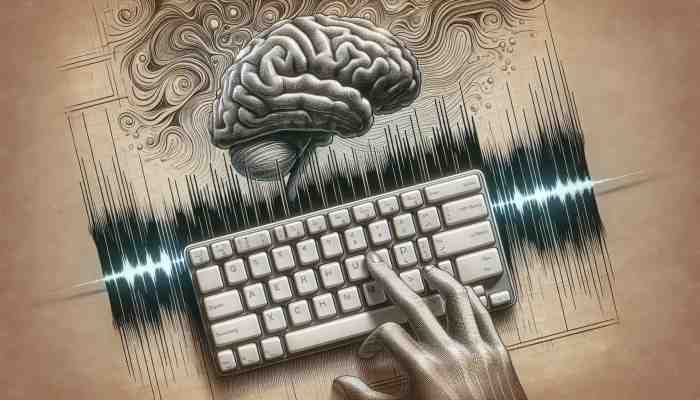# The Psychology of Keyboard Sounds: Impact on Typing
In the world of typing tests and keyboard enthusiasts, we often focus on metrics like WPM (words per minute) and accuracy. But have you ever considered how the sound of your keyboard might be affecting your typing speed and overall performance? Today, we're diving into the fascinating realm of keyboard acoustics and their psychological impact on typists. So, grab your favorite clicky, thocky, or silent board, and let's explore the symphony of keystrokes!
# The Sound and the Fury: How Keyboard Noise Affects Us
# The ASMR Effect
For some, the sound of typing is pure bliss. It's no coincidence that "keyboard typing" videos have become a popular subgenre of ASMR (Autonomous Sensory Meridian Response) content. The rhythmic clacking of keys can induce a sense of calm and focus, potentially improving typing speed and accuracy during a typing test.
# The Productivity Placebo
There's something satisfying about hearing the rapid-fire clicks as your fingers dance across the keyboard. This auditory feedback can create a placebo effect, making you feel more productive and potentially increasing your WPM. It's like the typing equivalent of a power pose – fake it 'til you make it, right?
# The Distraction Factor
On the flip side, loud keyboard sounds can be a double-edged sword. While they might make you feel like a typing virtuoso, they could also be distracting to others around you (and potentially yourself). If you're taking a typing test in a shared space, consider the impact your keyboard's decibel level might have on your concentration and that of those nearby.
# Keyboard Sound Profiles: A Typist's Guide
# Clicky Switches: The Typing Test Tempo-Setter
Keyboards with clicky switches, like the infamous Cherry MX Blue, provide distinct tactile and auditory feedback. This can help typists maintain a steady rhythm during a typing test, potentially leading to higher WPM scores. However, the loud clicks might not be suitable for all environments.
# Tactile Switches: The Silent Performer
Tactile switches offer a compromise between feedback and noise level. They provide a bump sensation without the loud click, making them ideal for those who want physical feedback without disturbing others. This could be the sweet spot for improving typing speed while maintaining office harmony.
# Linear Switches: The Stealth Typer
Linear switches, known for their smooth keystroke without tactile feedback, are the ninjas of the keyboard world. While they may not provide the same satisfying click as their louder counterparts, they allow for rapid typing with minimal noise. This could be beneficial for those who find auditory feedback distracting during a typing test.
# Membrane Keyboards: The Quiet Compromise
Often overlooked in the mechanical keyboard craze, membrane keyboards offer a quieter typing experience. While they may not provide the same tactile satisfaction, their muted sound profile can be less distracting in quiet environments, potentially allowing for better focus during typing tests.
# The Science Behind the Sound
# Auditory-Motor Synchronization
Research has shown that rhythmic sounds can influence motor behavior. In the context of typing, the consistent sound of keystrokes may help synchronize finger movements, potentially leading to improved typing speed and accuracy.
# Cognitive Load and Typing Performance
The sound of typing can affect cognitive load – the amount of working memory being used. For some, the auditory feedback reduces cognitive load by providing confirmation of each keystroke. For others, it may increase cognitive load by demanding additional attention. Understanding your personal response to keyboard sounds can help you optimize your typing test environment.
# The Role of Dopamine
The satisfying click of a mechanical keyboard may trigger a small dopamine release in the brain. This feel-good neurotransmitter could potentially reinforce the act of typing, making it more enjoyable and possibly improving performance over time.
# Optimizing Your Typing Test Environment
# Finding Your Sonic Sweet Spot
Experiment with different keyboard types and sound levels to find what works best for you. Some typing test websites, including TypeTest.io, allow you to customize the keystroke sound, letting you find the perfect audio feedback for your typing sessions.
# Active Noise Cancellation: Friend or Foe?
If you're using headphones with active noise cancellation (ANC) during your typing tests, be aware that it might affect your perception of keyboard sounds. Some typists find that ANC improves their focus, while others prefer to hear their keystrokes clearly.
# The Importance of Consistency
Whatever sound profile you choose, consistency is key. Using the same keyboard or sound environment for practice and actual typing tests can help build muscle memory and improve overall performance.
# Harnessing the Power of Sound for Typing Mastery
Understanding the psychological impact of keyboard sounds on typing performance is just one piece of the puzzle in your journey to becoming a typing test champion. By being mindful of your auditory environment and choosing the right keyboard for your needs, you can create the optimal conditions for improving your WPM and accuracy.
Remember, the best typing setup is one that works for you. Whether you're a fan of the loud and proud mechanical keyboards or prefer the whisper-quiet touch of a membrane board, the key is to find a sound profile that keeps you in the zone and your fingers flying across the keys.
So, the next time you sit down for a typing test, take a moment to listen to the symphony of your keystrokes. You might just find that the right sound is music to your fingers, helping you achieve new personal bests in typing speed and accuracy.
Ready to put your newfound knowledge to the test? Head over to TypeTest.io and see how different sound settings affect your typing performance. Who knows, you might just discover your perfect typing rhythm and set a new WPM record!
